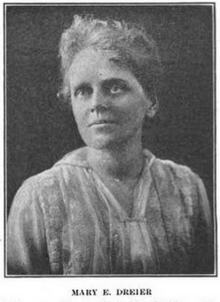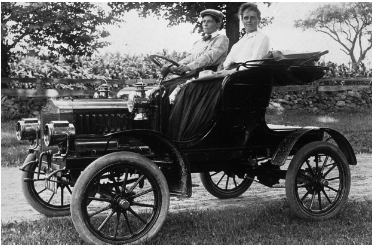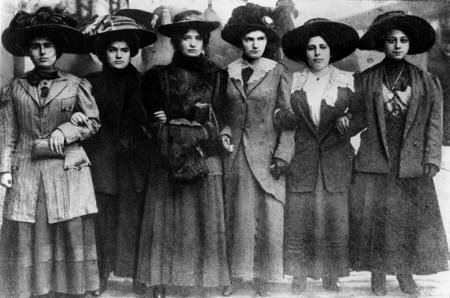BURIED TOGETHER
Partner Frances Kellor, buried together
Queer Places:
6 Montague Terrace, Brooklyn, NY 11201, Stati Uniti
118 E 54th St, New York, NY 10022, Stati Uniti
43 5th Ave, New York, NY 10003
Green-Wood Cemetery, 500 25th St, Brooklyn, NY 11232, Stati Uniti
 Mary
Dreier (September 26, 1875 - August 15, 1963) was a New York social
reformer. Frances Kellor, an
investigator at Hull-House and at the Rivington Street Settlement in New
York, and a shaper of much Progressive Era welfare legislation, met
Mary Dreier, a prominent labour reformer
and trade unionist, in 1904 and set up house with her for the 47 remaining
years of her life; a photograph of Kellor and Dreier in a high-seated open
motor car presents almost a caricature of the heterosexual couple: Kellor,
in a man’s cap, shirt and tie, is the man behind the wheel, Dreier is the
long-skirted decorous feminine person seated beside. A labor reformer and suffragist, Dreier was active in the New York Women's Trade Union League (WTUL) throughout its existence (1903-1950), serving as president from 1906 to 1914. Her sisters were Margaret Dreier Robins, a founder and president of the National WTUL, and Dorothea and Katherine, both artists. Katherine was best known as a patron of modern art.
Mary
Dreier (September 26, 1875 - August 15, 1963) was a New York social
reformer. Frances Kellor, an
investigator at Hull-House and at the Rivington Street Settlement in New
York, and a shaper of much Progressive Era welfare legislation, met
Mary Dreier, a prominent labour reformer
and trade unionist, in 1904 and set up house with her for the 47 remaining
years of her life; a photograph of Kellor and Dreier in a high-seated open
motor car presents almost a caricature of the heterosexual couple: Kellor,
in a man’s cap, shirt and tie, is the man behind the wheel, Dreier is the
long-skirted decorous feminine person seated beside. A labor reformer and suffragist, Dreier was active in the New York Women's Trade Union League (WTUL) throughout its existence (1903-1950), serving as president from 1906 to 1914. Her sisters were Margaret Dreier Robins, a founder and president of the National WTUL, and Dorothea and Katherine, both artists. Katherine was best known as a patron of modern art.
Mary Elisabeth Dreier was born in New York city New York, on September
26, 1875.[1]
Her parents, Theodor Dreier, a successful businessman, and Dorthea Dreier,
were both immigrants from Germany.[2]
Her mother's maiden name was Dreier and her parents were cousins from
Bremen, Germany, where their ancestors were civic leaders and
merchants. Theodor came to the United States in 1849 and became partner at
the New York branch of the English iron firm of Naylor, Benson and
Company. He married Dorthea in 1864 during a visit to Bremen and brought
her back with him to the United States, and they lived in a brownstone
house in
Brooklyn Heights, New York.[1]
Mary had a brother and three sisters;[2]
her sister
Margaret was also a labor reformer, while her sisters
Dorothea and
Katherine were painters.[1]
Mary was educated by private tutors for the early part of her life, and
later took courses at the New York School of Philanthropy. Her initial
financial support came in the form of a trust fund left by her father. She
and her sister Margaret worked hand-in-hand throughout her career.

Frances Kellor and Mary Dreier

Six women including Mary Dreier, Ida Rauh, Helen Marot, Rena Borky, Yetta Raff, and Mary Effers link arms as they march to City Hall on December 3, 1909 during the New York shirtwaist strike to demand an end to abuse by police.
She never married, but shared a home with fellow reformer
Frances
Kellor from 1905 until the latter's death in 1952. She lived alone for the
rest of her life until dying of a pulmonary embolism on August 15, 1963,
at her summer home in Bar Harbor, Maine, and is buried alongside Frances
Kellor at
Green-Wood Cemetery, Brooklyn, New York. Mary Elisabeth Dreier
represents the involved philanthropist of the early twentieth century.
From a financially secure family, she constantly contributed time, funds,
and organizing talents to a variety of feminist causes, most notably women
workers and the suffrage movement. Her social prominence and social
commitments led to her service on local and regional boards and
commissions, particularly those dealing with labor and with penal reform.
It was her strong religious background that motivated Dreier to take up
religious reform. She focused on working women, women suffrage, and social
and civic improvement.
In 1899, she met Leonora O’Reilly, who was a former garment worker and
head of a local settlement house at the time. Leonora was the one to
connect Mary and her sister Margaret with the settlement house. They
joined the New York Women's Trade Union League (NYWTUL), a coalition of
female workers and middle- and upper-class women reformers founded in 1903
to organize working women and educate the public about urban labor
conditions. Dreier served as president of the NYWTUL from 1906 to 1914, as
acting president in 1935, and remained active until it disbanded in 1950.
During a 1909 strike of shirtwaist-makers, she was arrested during a
demonstration. However, after that she became a leading spokeswoman for
labor reform for women workers. During her presidency, the New York group
was particularly active among garment workers, supporting their
organization in the International Ladies’ Garment Workers’ Union and
assisting them in strike activities.
From 1911 to 1915, she served on the New York State Factory
Investigating Commission, which provided evidence for the passage of
factory reform legislation. She also wrote articles for the WTUL’S
journal, Life and Labor, to encourage unionization. In 1915, Mayor John
Mitchell appointed her to the New York City Board of Education, but she
resigned all posts in 1915 in order to participate completely in the final
drive to achieve the vote for women.
In 1917, Dreier became chairwoman of the New York State Committee on
Women in Industry of the Advisory Commission of the Council of National
Defense. After the war she was a member of the executive committee of the
New York Council for Limitation of Armaments (1921-1927) and headed the
Committee for the Outlawry of War of the WTUL.
Dreier became an ardent supporter of suffrage and women's rights and
chaired New York City's Woman Suffrage Party due to the negative attitude
of the male trade unionists towards women workers. On the national level
she often supported Progressive Party nominees, including
Robert M. La Follette Sr. and
Henry A. Wallace, and she later became an enthusiastic backer of
Franklin D. Roosevelt and the New Deal.
When Eleanor Roosevelt and
Rose Schneiderman met in 1922, the New York League was run by union women. Schneiderman was president and
Maud Swartz was secretary. Eleven of the twelve board members were union members, with Mary Dreier, sister of the founder, the only remaining "ally" in a policy-making position.
Dreier served on several government and private committees concerned
with labor and women. Later in her career, she devoted more of her
attention to international issues and American foreign policy. Between the
world wars she supported Soviet-American friendship and was an outspoken
opponent of the regime in Nazi Germany. Following World War II she opposed
nuclear proliferation. In the 1950s the FBI investigated her politics.
In 1914 she wrote Barbara Richards, a novel about working women
that remained unpublished. In 1950 she published a biography of her
sister, Margaret Dreier Robins: Her Life, Letters and Work.
My published books:


BACK TO HOME PAGE

 Mary
Dreier (September 26, 1875 - August 15, 1963) was a New York social
reformer. Frances Kellor, an
investigator at Hull-House and at the Rivington Street Settlement in New
York, and a shaper of much Progressive Era welfare legislation, met
Mary Dreier, a prominent labour reformer
and trade unionist, in 1904 and set up house with her for the 47 remaining
years of her life; a photograph of Kellor and Dreier in a high-seated open
motor car presents almost a caricature of the heterosexual couple: Kellor,
in a man’s cap, shirt and tie, is the man behind the wheel, Dreier is the
long-skirted decorous feminine person seated beside. A labor reformer and suffragist, Dreier was active in the New York Women's Trade Union League (WTUL) throughout its existence (1903-1950), serving as president from 1906 to 1914. Her sisters were Margaret Dreier Robins, a founder and president of the National WTUL, and Dorothea and Katherine, both artists. Katherine was best known as a patron of modern art.
Mary
Dreier (September 26, 1875 - August 15, 1963) was a New York social
reformer. Frances Kellor, an
investigator at Hull-House and at the Rivington Street Settlement in New
York, and a shaper of much Progressive Era welfare legislation, met
Mary Dreier, a prominent labour reformer
and trade unionist, in 1904 and set up house with her for the 47 remaining
years of her life; a photograph of Kellor and Dreier in a high-seated open
motor car presents almost a caricature of the heterosexual couple: Kellor,
in a man’s cap, shirt and tie, is the man behind the wheel, Dreier is the
long-skirted decorous feminine person seated beside. A labor reformer and suffragist, Dreier was active in the New York Women's Trade Union League (WTUL) throughout its existence (1903-1950), serving as president from 1906 to 1914. Her sisters were Margaret Dreier Robins, a founder and president of the National WTUL, and Dorothea and Katherine, both artists. Katherine was best known as a patron of modern art.



